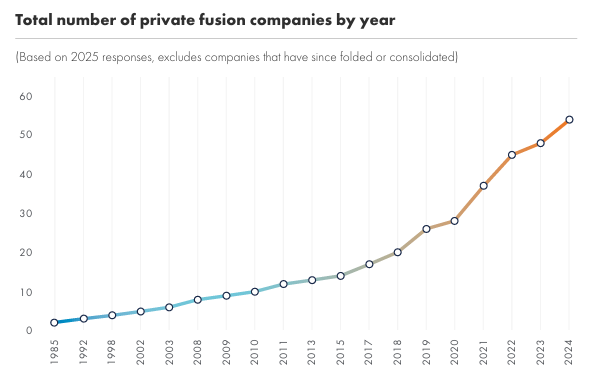
Paying for Nuclear Fusion: An Atomic Bang for Your Buck
Nuclear fusion is close to becoming a $10 billion industry without generating any electricity—private companies haven’t achieved ignition. Though energy isn’t quite rolling in, cash certainly is. With many in the science and tech community referring to fusion as the “holy grail” of energy production, optimistic investors know now is the time to invest and are eager to plug in and, hopefully, ride the wave.
After World War II witnessed the destructive capabilities of nuclear energy, politicians and scientists around the world—led by President Dwight D. Eisenhower’s Atoms for Peace speech—came together to put their nuclear knowledge to good use. With the Manhattan Project having rapidly unlocked nuclear fission—splitting the atom—in a matter of years, some were hoping for a relatively unimpeded path towards nuclear fusion weaponry and energy production. Many decades and billions of dollars later, thermonuclear hydrogen bombs (fusion bombs) exist around the world, but controlled, net energy generation from fusion remains elusive. So why is so much capital still flowing into fusion?
Fusion offers a novel approach to a timeless product: energy. Without emitting greenhouse gases, fusion generates 20-100 million times more energy per reaction than fossil fuels. This unparalleled energy density is bolstered by the fact that fusion runs on hydrogen—a functionally inexhaustible, sustainable source of fuel. In short, fusion has the potential to future-proof the energy industry. No matter how difficult the unresolved issues are, these upsides make investors stop and seriously consider fusion.
There isn’t a “right way” to do fusion, but only one method has worked: inertial confinement fusion (ICF). During ICF, a small pellet of fusion fuel is held at the center of a large sphere and then rapidly compressed by lasers, electric/magnetic fields, and/or projectiles. The National Ignition Facility (NIF) at Lawrence Livermore National Laboratories (LLNL) successfully achieved ignition using ICF in 2022. Though NIF was able to reach ignition, their priority is national defense, so they have little intention of commercializing the technology for energy generation.

While NIF’s design won’t become a power plant, they’ve proven that net energy from fusion is feasible today. As such, the fusion industry’s primary quest looks much different now than it did a few decades ago. Instead of hoping for fusion to exist, we know it does. This NIF breakthrough sent a shockwave through the fusion world that eventually landed on investors’ desks. The news rapidly gave way to strong-willed start-ups with enormous capital—like the well-staffed leading ICF company, Pacific Fusion, and its $900 million series A—looking to build what NIF won’t. With NIF’s proof of concept and the “promise” of unlimited clean energy seemingly closer than ever, it’s not difficult to understand why fusion turns investors’ heads.
Since 2021, the number of fusion start-ups recognized by the Fusion Industry Association has increased 90% – 95%, with around 25 new companies.
During those same years, two future fusion power purchase agreements were signed by tech hyperscalers—Microsoft x Helion (2023) and Google x Commonwealth Fusion Systems (2025). Between July 2024 and July 2025, the industry has seen a 36% growth in historic funding; that’s roughly $2.6 billion. If anything is clear, it’s that fusion has picked up speed after NIF’s critical advancements.


Despite the recent achievement, fusion still faces numerous unresolved engineering hurdles. In addition, though fusion is possible, it is extremely energy-intensive. Before any commercial plants can be constructed, companies must prove they can harness fusion’s energy in a net positive fashion. The primary obstacle to overcome has to do with constructing a machine that can sustain the immense temperatures and pressures necessary for fusion. This requires the development of new heat-resistant materials, generator designs, and energy extraction methods alongside a more comprehensive understanding of burning plasmas—super hot, self-warming ionized gas. To ground this issue, the conditions within a fusion machine are comparable to those at the center of the sun. That’s everything except easy to achieve.
The fusion industry has no shortage of issues, but it’s well equipped for the road ahead. In the face of a warming climate and increasing energy demand, unlimited clean energy really doesn’t sound too bad at all. Though the journey has been winding, exhausting, and obscure so far, investors are now backing the industry like never before and renewing scientists’ endurance to unlock the unprecedented amounts of energy tucked away in atoms. This financial boost, paired with technical advancement after advancement, has proven that fusion is much more an optimization game—an enormously difficult one at that—than a laboratory party trick. What’s left to do: invest and tread on.
Tobey Theiding
Student Advisory Council MemberTobey Theiding is an undergraduate in the College of Arts & Sciences studying physics. Theiding is a Student Advisory Council Member and was 2025 Undergraduate Fellow.

